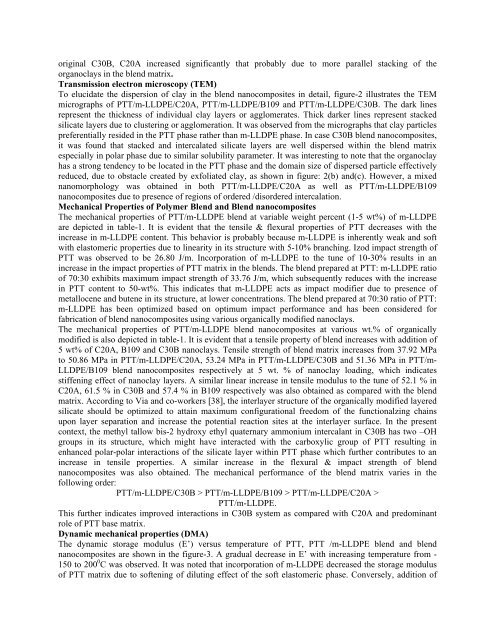Nondestructive testing of defects in adhesive joints
Nondestructive testing of defects in adhesive joints
Nondestructive testing of defects in adhesive joints
Create successful ePaper yourself
Turn your PDF publications into a flip-book with our unique Google optimized e-Paper software.
orig<strong>in</strong>al C30B, C20A <strong>in</strong>creased significantly that probably due to more parallel stack<strong>in</strong>g <strong>of</strong> the<br />
organoclays <strong>in</strong> the blend matrix.<br />
Transmission electron microscopy (TEM)<br />
To elucidate the dispersion <strong>of</strong> clay <strong>in</strong> the blend nanocomposites <strong>in</strong> detail, figure-2 illustrates the TEM<br />
micrographs <strong>of</strong> PTT/m-LLDPE/C20A, PTT/m-LLDPE/B109 and PTT/m-LLDPE/C30B. The dark l<strong>in</strong>es<br />
represent the thickness <strong>of</strong> <strong>in</strong>dividual clay layers or agglomerates. Thick darker l<strong>in</strong>es represent stacked<br />
silicate layers due to cluster<strong>in</strong>g or agglomeration. It was observed from the micrographs that clay particles<br />
preferentially resided <strong>in</strong> the PTT phase rather than m-LLDPE phase. In case C30B blend nanocomposites,<br />
it was found that stacked and <strong>in</strong>tercalated silicate layers are well dispersed with<strong>in</strong> the blend matrix<br />
especially <strong>in</strong> polar phase due to similar solubility parameter. It was <strong>in</strong>terest<strong>in</strong>g to note that the organoclay<br />
has a strong tendency to be located <strong>in</strong> the PTT phase and the doma<strong>in</strong> size <strong>of</strong> dispersed particle effectively<br />
reduced, due to obstacle created by exfoliated clay, as shown <strong>in</strong> figure: 2(b) and(c). However, a mixed<br />
nanomorphology was obta<strong>in</strong>ed <strong>in</strong> both PTT/m-LLDPE/C20A as well as PTT/m-LLDPE/B109<br />
nanocomposites due to presence <strong>of</strong> regions <strong>of</strong> ordered /disordered <strong>in</strong>tercalation.<br />
Mechanical Properties <strong>of</strong> Polymer Blend and Blend nanocomposites<br />
The mechanical properties <strong>of</strong> PTT/m-LLDPE blend at variable weight percent (1-5 wt%) <strong>of</strong> m-LLDPE<br />
are depicted <strong>in</strong> table-1. It is evident that the tensile & flexural properties <strong>of</strong> PTT decreases with the<br />
<strong>in</strong>crease <strong>in</strong> m-LLDPE content. This behavior is probably because m-LLDPE is <strong>in</strong>herently weak and s<strong>of</strong>t<br />
with elastomeric properties due to l<strong>in</strong>earity <strong>in</strong> its structure with 5-10% branch<strong>in</strong>g. Izod impact strength <strong>of</strong><br />
PTT was observed to be 26.80 J/m. Incorporation <strong>of</strong> m-LLDPE to the tune <strong>of</strong> 10-30% results <strong>in</strong> an<br />
<strong>in</strong>crease <strong>in</strong> the impact properties <strong>of</strong> PTT matrix <strong>in</strong> the blends. The blend prepared at PTT: m-LLDPE ratio<br />
<strong>of</strong> 70:30 exhibits maximum impact strength <strong>of</strong> 33.76 J/m, which subsequently reduces with the <strong>in</strong>crease<br />
<strong>in</strong> PTT content to 50-wt%. This <strong>in</strong>dicates that m-LLDPE acts as impact modifier due to presence <strong>of</strong><br />
metallocene and butene <strong>in</strong> its structure, at lower concentrations. The blend prepared at 70:30 ratio <strong>of</strong> PTT:<br />
m-LLDPE has been optimized based on optimum impact performance and has been considered for<br />
fabrication <strong>of</strong> blend nanocomposites us<strong>in</strong>g various organically modified nanoclays.<br />
The mechanical properties <strong>of</strong> PTT/m-LLDPE blend nanocomposites at various wt.% <strong>of</strong> organically<br />
modified is also depicted <strong>in</strong> table-1. It is evident that a tensile property <strong>of</strong> blend <strong>in</strong>creases with addition <strong>of</strong><br />
5 wt% <strong>of</strong> C20A, B109 and C30B nanoclays. Tensile strength <strong>of</strong> blend matrix <strong>in</strong>creases from 37.92 MPa<br />
to 50.86 MPa <strong>in</strong> PTT/m-LLDPE/C20A, 53.24 MPa <strong>in</strong> PTT/m-LLDPE/C30B and 51.36 MPa <strong>in</strong> PTT/m-<br />
LLDPE/B109 blend nanocomposites respectively at 5 wt. % <strong>of</strong> nanoclay load<strong>in</strong>g, which <strong>in</strong>dicates<br />
stiffen<strong>in</strong>g effect <strong>of</strong> nanoclay layers. A similar l<strong>in</strong>ear <strong>in</strong>crease <strong>in</strong> tensile modulus to the tune <strong>of</strong> 52.1 % <strong>in</strong><br />
C20A, 61.5 % <strong>in</strong> C30B and 57.4 % <strong>in</strong> B109 respectively was also obta<strong>in</strong>ed as compared with the blend<br />
matrix. Accord<strong>in</strong>g to Via and co-workers [38], the <strong>in</strong>terlayer structure <strong>of</strong> the organically modified layered<br />
silicate should be optimized to atta<strong>in</strong> maximum configurational freedom <strong>of</strong> the functionalz<strong>in</strong>g cha<strong>in</strong>s<br />
upon layer separation and <strong>in</strong>crease the potential reaction sites at the <strong>in</strong>terlayer surface. In the present<br />
context, the methyl tallow bis-2 hydroxy ethyl quaternary ammonium <strong>in</strong>tercalant <strong>in</strong> C30B has two –OH<br />
groups <strong>in</strong> its structure, which might have <strong>in</strong>teracted with the carboxylic group <strong>of</strong> PTT result<strong>in</strong>g <strong>in</strong><br />
enhanced polar-polar <strong>in</strong>teractions <strong>of</strong> the silicate layer with<strong>in</strong> PTT phase which further contributes to an<br />
<strong>in</strong>crease <strong>in</strong> tensile properties. A similar <strong>in</strong>crease <strong>in</strong> the flexural & impact strength <strong>of</strong> blend<br />
nanocomposites was also obta<strong>in</strong>ed. The mechanical performance <strong>of</strong> the blend matrix varies <strong>in</strong> the<br />
follow<strong>in</strong>g order:<br />
PTT/m-LLDPE/C30B > PTT/m-LLDPE/B109 > PTT/m-LLDPE/C20A ><br />
PTT/m-LLDPE.<br />
This further <strong>in</strong>dicates improved <strong>in</strong>teractions <strong>in</strong> C30B system as compared with C20A and predom<strong>in</strong>ant<br />
role <strong>of</strong> PTT base matrix.<br />
Dynamic mechanical properties (DMA)<br />
The dynamic storage modulus (E’) versus temperature <strong>of</strong> PTT, PTT /m-LLDPE blend and blend<br />
nanocomposites are shown <strong>in</strong> the figure-3. A gradual decrease <strong>in</strong> E’ with <strong>in</strong>creas<strong>in</strong>g temperature from -<br />
150 to 200 0 C was observed. It was noted that <strong>in</strong>corporation <strong>of</strong> m-LLDPE decreased the storage modulus<br />
<strong>of</strong> PTT matrix due to s<strong>of</strong>ten<strong>in</strong>g <strong>of</strong> dilut<strong>in</strong>g effect <strong>of</strong> the s<strong>of</strong>t elastomeric phase. Conversely, addition <strong>of</strong>

















